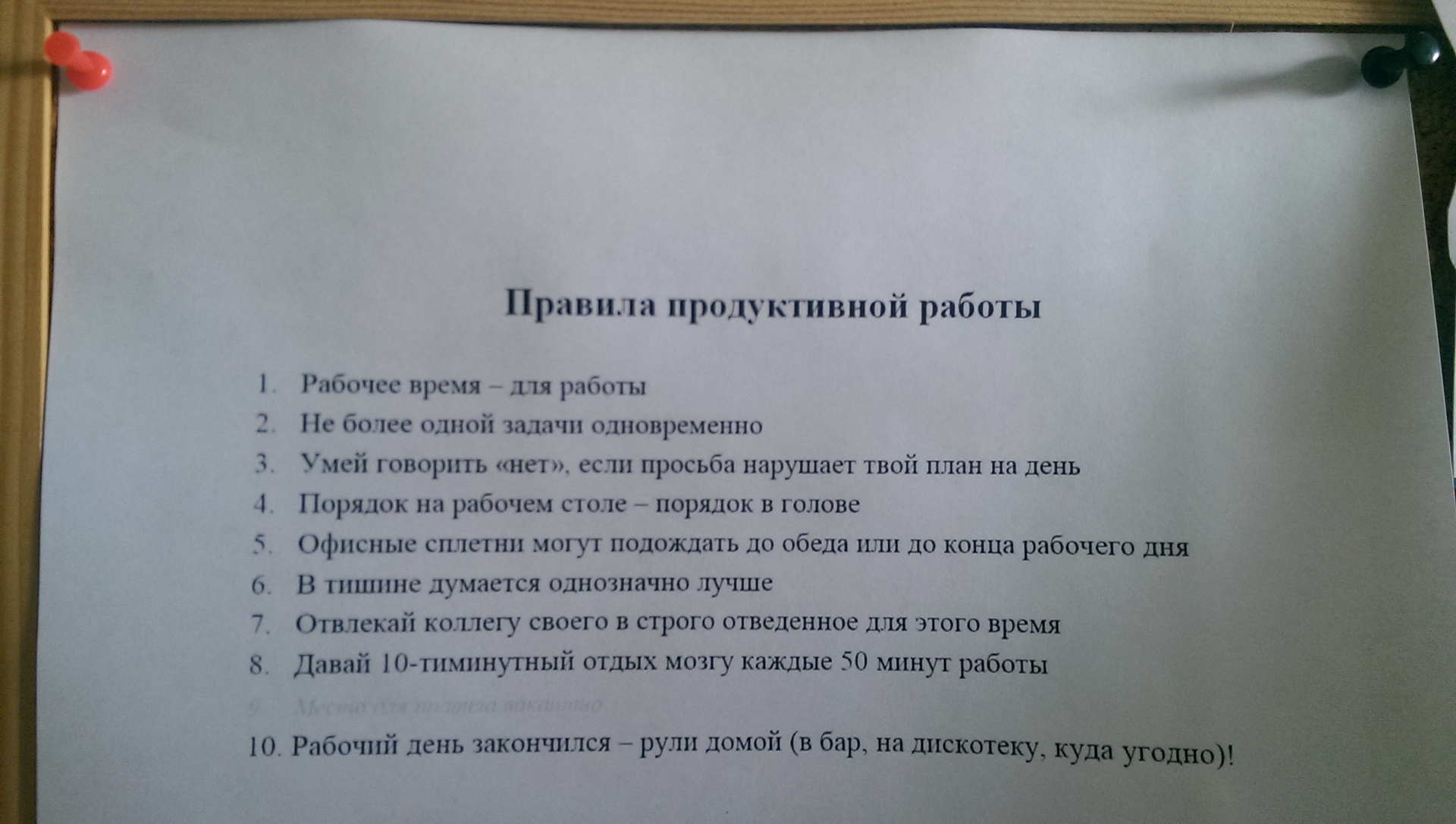5 ways to increase personal and team productivity

Not much has been written about improving productivity today. Time management gurus talk about how to “get more done on your work day,” motivation experts share secret practices that will help get rid of procrastination and laziness; companies make gadgets and software to increase productivity.
I will not try to grasp the immensity and tell you about my own methods of increasing productivity. They are “run-in” not only for me: a small team of like-minded people was formed as part of the IT department, and also a curious marketer and HR joined us.
Over the course of the month, we tried various tips that we gleaned from books, online articles, conversations with colleagues, and personal experience. And here's what they came to:
1. Do you want to work better - do not be distracted
Multitasking is a myth inspired by the fame of Julius Caesar and actively promoted by consultant trainers. Studies by scientists have repeatedly confirmed that switching from task to task or just distraction takes a person 15-25 minutes of time. In addition, “our brain is not able to concentrate and maintain working capacity, solving several problems,” says psychologist Guy Vinc.
To focus on business, we got rid of distractions (we took advantage of a program that blocks access to the Internet for a certain time) and formulated “rules for productive work”, which were hung in a prominent place.

2. Do not ignore procrastination in solitary work, and in the team - the Ringelman effect
Someone claims that procrastination originates from the desire for perfectionism, someone that this is an extremely neglected manifestation of laziness. In any case, the fight against it must be carried out systematically and methodically. Subject marketing and eychar (available in the company in the singular) tested the methodology of Cal Newport, the author of a blog about productivity and efficiency. The professor suggests not just compiling to-do lists, but allotting a specific amount of time to each case. But the main thing that helped our humanitarian heroes was the attention of our colleagues. The entire IT department watched them with interest and, according to the experimental, this motivated them to work better.
As for the Ringelman effect, it manifests itself precisely in teamwork. Its essence is to reduce the productivity of workers as the group in which they work grows. Ringelman explains this state of affairs by the loss of individual motivation. The employee, realizing that the responsibility for the task lies with the whole group, puts less effort. Another reason for the decline in productivity is the need to coordinate activities between group members.
Nobody planned to expand the IT department, but we still tried to increase motivation and improve coordination of the activities of existing members of the group. They decided to clearly identify for each area of responsibility, while reporting on meetings with success stories and problems. It turned out pretty well: at least it’s immediately obvious who is working on what and who is doing great, and who is not very good.
3. Adopt the best practices from others
Reading about productivity gains is good. But to adopt the positive experience of acquaintances / colleagues / friends is even better. We were convinced of this thesis by working together with a marketer and HR manager. Having visited our planning meeting, they decided to use flexible methodologies in their work. At the same time, they prompted us several ideas for motivation (we finally introduced gamification into the work of the department with the help of HR, and we plan to subsequently extend it to the whole company).
Another example: our PR specialists borrowed experience in working with CRM from the sales department and are now successfully using the system in working with journalists. The deal with them is the publication of an article, the stages of sales are the stages of contact with a journalist (initial contact, negotiations, writing an article, publication). Again, you can keep statistics, watch the funnel and count conversions perfectly.
4. Streamline processes. Analyze what you spend your time and team time
Before you do the optimization, you need to analyze: what do we actually have and what can be improved? Another program helped us in this (in fact, there are quite a lot of them, we tried this one ), which collected statistics from our computers for two weeks. We quite easily found weaknesses in our own activities, we were also able to identify the most productive of us and tried to find out what is the secret of the heroes (this brings us back to the previous point).
Briefly about successes: saving time by automating processes (they wrote a script to a marketer who brings monthly reports together and builds beautiful charts - he used to do this in Excel); saw that two testers do not use scripts to collect screenshots and lose a lot of time because of this.
We made templates for standard documents, which reduced the time spent working with them by at least 5 minutes a day (in terms of each employee per week - good savings are obtained).
5. Focus on priorities
Parkinson’s law states: “Work takes as much time as it takes.” That is why, you need to prioritize tasks and do only important things. Trivia, such as parsing email, unplanned meetings and office conversations, current affairs, take up the lion's share of the work day. The worst thing is that we like it, because a lot of effort is not spent on minor tasks.
We approached the issue in a systematic way: at first we sorted all the work “on the bones”, divided it into directions, discussed and prioritized. Then, we determined the working time that will be allocated for these tasks. We used the Pareto rule (80% for priority tasks, 20% for turnover).
And how do you increase productivity?
